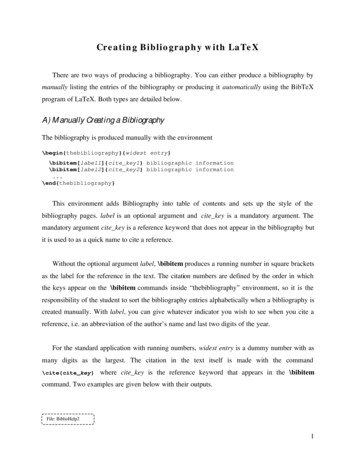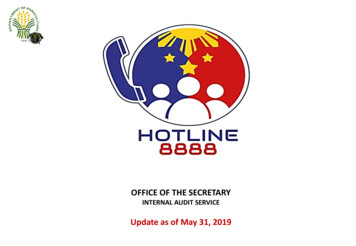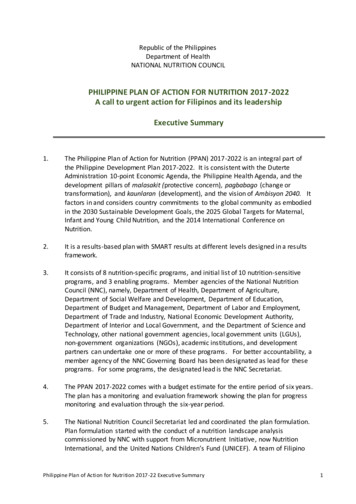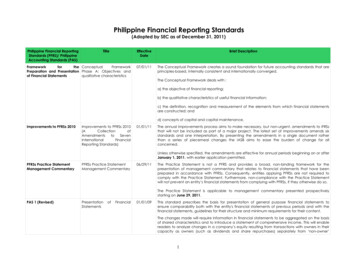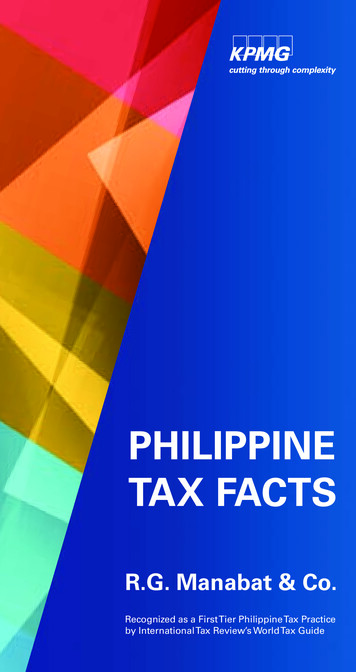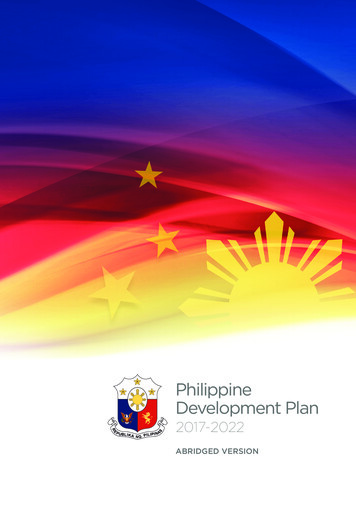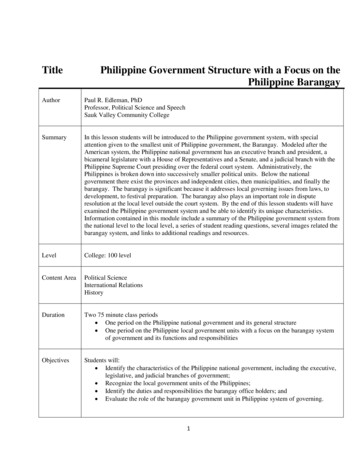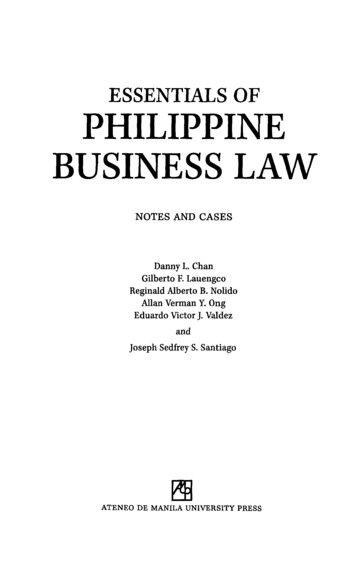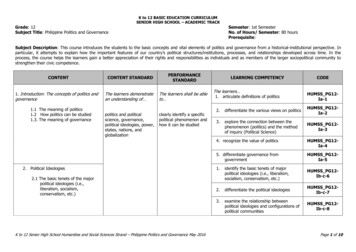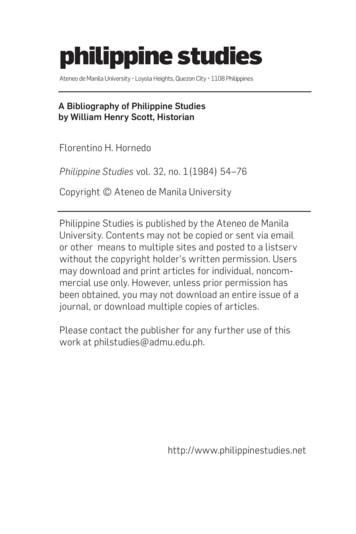
Transcription
philippine studiesAteneo de Manila University Loyola Heights, Quezon City 1108 PhilippinesA Bibliography of Philippine Studiesby William Henry Scott, HistorianFlorentino H. HornedoPhilippine Studies vol. 32, no. 1(1984) 54–76Copyright Ateneo de Manila UniversityPhilippine Studies is published by the Ateneo de ManilaUniversity. Contents may not be copied or sent via emailor other means to multiple sites and posted to a listservwithout the copyright holder’s written permission. Usersmay download and print articles for individual, noncommercial use only. However, unless prior permission hasbeen obtained, you may not download an entire issue of ajournal, or download multiple copies of articles.Please contact the publisher for any further use of thiswork at es.net
Philippine Studiea 32(1984):5476A Bibliography of Philippine Studies byWilliam Henry Scott, HistorianF L O R E N T I N O H. H O R N E D 0In 1982, William Henry Scott completed twenty-five years ofteaching, scholarship and publication in the Philippines. If thequality of mind and heart that glows through his writings is anindication, as I think it is, of what he has been as a teacher, it isnot difficult to understand why he has been called the writer of"the fifth Gospel." The association with the Gospel is not accidental, for Scott is an American Episcopalian lay missionary whochose to be a teacher of history; and has become a historian ofoutstanding achievement.In his "Preface" to his "Prehispanic Source Materials for theStudy of Philippine History," he wrote:.The author .wishes well to the Filipino people and believed thattheir future destiny is already planted in their past. He is a professionalmissionary convinced that no people will take its full place in the commonfamily of man without a sense of that destiny. And he is a history teacherwhose classroom experience in another Oriental republic has persuadedhim that the substitution of popular mythology for sound history willquickly bankrupt that sense of destiny. What more could he ask than theopportunity to contribute his little mite to stay that bankruptcy?'The writing and teaching of "sound history" has been Scott'sobsession. Although he has been popularly known as the historianof the Igorots, he has made a more basic contribution to Philippine historiography - that of methodology in history. In 1963,an article of his titled "The Propm Use of Documents," and pub1. Uiritas41 (September 1968): 281.
WILLIAM HENRY SCOTT, HISTORIAN55lished in Philippine Studies, aroused a good deal of controversy.His 1968 "Prehispanic Source Materials . . . " was a superb workof historiographic sleuthing. After he unmasked some dozen documents and "codes" (including the famous Maragtas and Kalantiaw), no Philippine history textbook could remain unchanged,except by those who would prefer popular mythology to soundhistory. This work did not prescribe a method - it demonstratedmethod. More recently, "Cracks in the Parchment C r t a i n , " noted the well-taken warning of Teodoro Agoncillo against careless use of Spanish documents for the writing of Philippine history"because the colonial government enjoyed a monopoly on theproduction of source material ." "Yet," Scott argues, "thereare cracks in that curtain, chinks, so to speak, through whichfleeting glimpses of Filipinos and their reactions to Spanishdominion may be seen.'* His works which appear in his 1982book (by New Day Publishers), Cracks in the Parchment Curtainand Other Essays in Philippine History, exemplify his method ofgathering "glimpses of Filipinos" in the past, and from themof constructing a fairly good picture of what happened "in thosedays."The rigor of his methodology as a historian has been the fruitof strict mental and moral honesty. That honesty has not beenlost on his students nor on many of the sons and daughters ofthe Mountain Province whom he had adopted as his own kinsmen.(Home for Scott is not in Detroit, U.S.A., but in Sagada, Mountain Province.)As his teaching and scholarly output began to bear fruit in anever growing "sense of destiny" in the youth within his reach,and as that sense of destiny converged with other forces unleashedon Philippine society in the late sixties and early seventies, it wasto see what the Gospel put so aptly: "the blind see, the lamewalk . . . the deaf hear . . . to the poor the Good News ispreached." (Luke 7:22) They saw the grave inequities in Philippine society, they walked the streets to protest against injusticesor the failure of man to love fellowmen. People high and lowheard the protests, and the poor learned that they did not have2. Philippine Studies 26 (1978): 174-91.3. Ibid., p. 174.4. Ibid.
56PHILLPPINE STUDIESto be oppressed all their lives. Then (1970-72) Scott's troublesbegan in earnest.President A. M. Guerrero of Trinity College of Quezon City,in a letter dated 23 October 1972, informed Scott that his "services will no longer be needed after the close of office hours onMonday, October 23, 1972." Guerrero believed that Scott had"engaged in certain activities which contravene the guidelinesissued by the Department of Education through its DepartmentOrders Nos. 27 and 30." He was a threat to the "interests - eventhe continued existence - of the College."The Secretary of the Department of National Defense, JuanPonce Enrile, issued an "Arrest, Search and Seizure Order"(ASSO) on 29 December 1972. The object of the ASS0 was the"Residence of Dr. William Henry Scott at Trinity College Compound." He was accused of "subversive activities."On 13 March 1973, Special Prosecutor I.L. Mariano of theCommission on Immigration and Deportation charged Scott withcrimes and acts that made him "an undesirable alien," and recommended that the "respondent be deported immediately fromthe Philippines . . . because his presence has been and will alwaysbe inimical to the peace, security and tranquility of the communit ." Meanwhile, Scott remained under military detention.By June 1973 he had been cleared by the deportation board,and the proceedings against him dropped. "I am truly grateful,"he said after his clearance, "for the decision of the Republic ofthe Philippines to allow me to stay in this my adopted country6and continue my humble service as a lay missionary, and as astudent and teacher of history."'As a "student" of history he continued to publish many studies, as the following list will show. As a teacher of history he wasreaching out to students in many, and sometimes distant, places.He was a professorial lecturer at the University of Santo Tomasgraduate school, at the University of the Philippines in Dilirnan,Quezon City, at the University of the Philippines in Baguio, and,of course, he was back at the Trinity College compound, where he5. Citations from the original communications are from copies obtained by thiswriter from Dr. Scott.6. He was accepted as a quota immigrant in 1966.7. Reported in the Detroit Free Press, 10 June 1973, under the head, "Philippinescads bid to deport former Detroiter."
WILLIAM HENRY SCOTT. HISTORIAN57taught Church History at St. Andrew's Theological Seminary.Scott studied at Yale, Columbia, and the University of SantoTomas where he obtained his Ph.D. in History. His voluminouswritings proved him to be a scholar of great quality and brilliance. But the human testimony of "profound respect, gratitude, appreciation and abiding love" from his administrativesuperiors and colleagues at St. Andrew's certainly eased someof the pain of "leaving the classroom for the last time" to beginretirement in March 1982.THE BIBLIOGRAPHIC LISTDr. Scott's writings have been topically both varied and numerous, ranging from history, ethnology, and linguistics, to folkloristic ,literature, inspirational and theological discourses. Thebibliography that follows is Dr. Scott's own. The flaws of editingare mine.The original list also included Scott's four publications from1937 to 1956.8 These are not included in this twenty-five yearbibliography which begins with 1957.More detailed annotation would be ideal under other circumstances, but to provide a comprehensive guide list to Scott's publications, cross references indicating other publications in whichindividual articles have been reprinted or published in revisedform will suffice.Where biographical notes shed light on the particular work,footnotes are used. Unless otherwise indicated the substance ofthe annotation was obtained from Scott himself.The following are the abbreviations of titles of journals, periodicals and books cited in the bibliography.8. "Tie Or@ of Gundpowder" by Ben E. Gunk. l7te h n e (reprinted by the kindpermission of m e Skeebawken Clrrrion (January 1937); 'The Eternal Battle," OurNavy 43, No. 10 (Mid-October 1948): 49; "The Feud," Our Navy 43, No. 20 (MidMarch 1949): 31; and "Self-Support: an Unmixed Blessing?," Episcopal OverseasMissiol yReview 2, NO.1 (Michaelmas 1956): 9-10.
58PHILIPPINE STUDIESPERIODICALS AND JOURNALSAA - American AnthropologistAFS - Ashn Folklore StudiesAS - Asian StudiesBMC - Baguio Midland CourierDR - Diliman ReviewEOMR - Episcopal Overseas Missonaty ReviewIRM - International Review o f MissionsPA - Practiml AnthropologyPE - Philippine EpiscopalbnPS - Philippine StudiesPSR - Philippine Sociological ReviewSI - Silliman JournalSIOA - Southwestern J o u r ofl AnthropologySTM - Sunday Times MagazineTAR - The Aglipqan ReviewTCR - The Christhn ReviewTGO - The Gold OreTNC - The Northern QIurchmanUBJ - University of Baguio JournalBOOKS-Cracks in the Parchment Curuin and Other Essays in Philippine History.Quezon City: New Day Publishers, 1982.300 pages.- History on the Cordillem. Baguio City: Baguio Printing and PublishingHOTCCo., 1975.- Hdlow ailrips on a Wine-dark Sea and Other Essays. Quezon City: NewHSWSDay Publishers, 1976. 115 pages.- On the Cordillera: A Look at the People and Culture of the MountainOTChvince. Manila: M. C. S. Enterprises, 1966.SYTC- Speaking to Youth in lTme of Crisis. Quezon City: New Day Booklet,New Day Publishers, 1972.WA YFY - Who are You, Filipino Youth? Quezon City: Tala Publishing Corp., 1976.CPCTitles of periodicals with short titles (e.g. Forth, Unitas), andbooks and publications that appear only once, have not beenabbreviated.
SCOTT BIBLIOGRAPHYPublished Works of William Henry Scott1957"A Terrace of Teaching in the Mountain Province. Forth 122,No. 25 (May 1957): 10-11."The Missionary Profession." EOMR 2, No. 3 (Whitsunday1957): 13-15.A Vocabulary of the Sagada Zgorot Dialect. Philippine StudiesProgram Transcript No. 6, Department of Anthropology,University of Chicago, June 1957."A Thousand New Tongues." Forth 122, No. 11 (December1957): 10.1958"Familiar Friend of the Filipinos: A Profde of the Rt. Rev. Lyman C. Ogilby." Forth 123, No. 1 (January 1958): 10."The Missionary as Foreigner." EOMR 3, No. 2 (Epiphany1958): 43-47.Reprinted in The Missionary as Foreigner (1972), pp. 1-7.Reprinted as "The Missionary as a Good Foreigner."Missiology 1, No. 3 (July 1973): 383-87.Reprinted as "Are Missionaries Still Foreign?" WorldEncounter 12, No. 3 (February 1979): 14-1 7."A Preliminary Report on Upland Rice in Northern Luzon."U O A 14, No. 1 (Spring 1958): 87-105.Reprinted in O X , pp. 1-28."Some Calendars of Northern Luzon." AA 60, No. 3 (June1958):563-70.Reprinted in O X , pp. 29-43.Abridged in Archipelago, Vol. 3, A-25 (1976), as "TheCalendars of the Cordilleras," pp. 34-38."Boyhood in Sagada." Anthropological Quarterly 3 1, No. 3 (July1958): 61-72.Reprinted in SJ 10, No. 4 (Fourth Quarter 1958): 387-98.Reprinted in O X , pp. 44-60.
PHILIPPINE STUDIES"A Psalm for Igorots." Anglican Theological Review 40, No. 3(July 1958): 189-204.Reprinted in O X , pp. 279-99."Economic and Material Culture of the Kalingas of Madukayan."SJOA 14, No. 3 (Autumn 1958): 318-37.Reprinted in O K , pp. 61-93.1959"Send or Be Sent." EOMR 4, No. 2 (Epiphany 1959): 3-6.Reprinted in pamphlet form as 'Why Should We Try toImpose Our Religion on People Who Already HaveOne?" by Foreward Publications (n.d.).1960"Coins and Society." The Numismatist 73, No. 1 (January1960): 41-44."Scholarships Help Igorot Boys Find the Way." Forth 125, No. 1(January 1960): 20-21."Social and Religious Culture of the Kalingas of Madukayan."SJOA 16, No. 1 (Summer 1960): 174-90.Reprinted in O K , pp. 94-122."Worship in Igorot Life." Paper read at the Second Baguio Religious Acculturation Conference, Baguio, December 1959;PSR 8, Nos. 3-4 (July-October 1960): 17-21; and SEAJT 4,No. 1 (July 1962): 66-72.Reprinted in O K , pp. 143-53."The Apo-Dios Concept in Northern Luzon." Paper read at theThird Baguio Religious Acculturation Conference, Baguio,2 January 1960;PS 8, No. 4 (1960): 772-88.Reprinted in PA 8, No. 5 (September-October 1961):207-16.Reprinted in O X , pp. 12342.Reprinted in Accultumtion in the Philippines, pp. 116-27.Edited by Peter G. Gowing and W.H. Scott. QuezonCity: New Day Publishers, 1971.1961"Comment on Francis Lambrecht's 'The Ifugao Law of Customin the Light of Natural Moral Law and Primitive Revelation:11.' " Paper read at the Fourth Baguio Religious AcculturationConference, Baguio, 30 December 1960; Proceedings of theFourth &Iguio Religious Accultumtion Conference. Manila,1961, pp. 44-73.Reprinted as "Ifugao Custom Law and the Moral Law."
SCOTT BIBLIOGRAPHY61"Sagada Legends." Journal of AmenencanFolklore 74, No. 291(January-March 1961): 57-62."St. Patrick's Missionary Methods." IRM 50, No. 198 (April1961): 137-48.Reprinted in HSWS, pp. 26-37.1962"The Philippine Independent Church in History." East and WestRdew 28, No. 1 (January 1962): 3-13.Reprinted in ,!U 10, No. 3 (1963): 1-13.(with Bartolome Daoas) "Sagada Igorot Conversation Course."Sagada Social Studies No. 11, March 1962. (Mimeographed.)"The Word 'Igorot.' "PS 10, No. 2 (1962): 234-48.Reprinted in STiU 18, No. 27 (10 February 1963): 42-44,and No. 28 (17 February 1963): 12-13.Reprinted in O K ,pp. 154-74.Revised version published as "Origin of Igorot" in BMC,23 and 30 January 1972."The Live Motit." SW 18, No. 6 (16 September 1962): 67.Reprinted in O K ,pp. 300-5."David, the Bacillus, and the Mensip-ok." EOMR 8, No. 1 (Michaelmas): 3-4. (Original mimeo as "S.P.S. Newsletter No. 13")."Staunton of Sagada: Christian Civilizer." Historical Magazine ofthe Protestant Episcopal Church 3 1, No. 4 (December 1962):305-39.Reprinted in HSWS, pp. 69-102.Abridged version published as "An Engineer's DreamJohn Staunton and the Mission of St. Mary the Virgin."In Gerald H. Anderson, ed., Studies in Philippine ChurchHistoly (1969), pp. 337-49."Cordillera Architecture of Northern Luzon." Folklore Studies21 (1 962): 186-220.Reprinted in Om,pp. 175-217.1963(with Fred Eggan) "Ritual Life of the Igorots of Sagada: FromBirth to Adolescence," Ethnology 2, No. 1 (January 1963):40.54."Growing Rice in Sagada." Philippine Journal of Economics 2,NO. 1 (1963): 85-97.
PHILIPPINE STUDIESReprinted in O X ,pp. 220-36.Abridged in Kalinangan 1, No. 2 (June 1975): 40-43."The Proper Use of Documents." PS 11, No. 2 (1963): 328.35.'Review of The Ethnohistory o f Northern Luzon, by Felix Keesing. AA 65, No. 4 (August 1963): 961-62."Some Contrasts in Missionary Patterns." Silliman ChristianLeader 15, No. 1 (October 1963): 3-10.Reprinted in IRM 54, No. 21 5 (July 1965): 3 15-24.Reprinted in PA 15, No. 6 (November-December 1968):269-76.Reprinted in The Missionary as Foreigner (1972), pp. 8-19.Abridged as "What Must We Carry on Mission?" EOMR 11,No. 1 (Michaelmas 1965): 19-22."Articles in Sagada Igorot." Philippine Journal for LanguageTeaching 2, Nos. 1-2 (October 1963): 8-20.Reprinted in OTC, pp. 237-52.1964"The Olympics." PS 12, No. 1 (1 964): 118-22.Review of The Hispanization o f the Philippines, by John LeddyPhelan. South-East Asia Journal of Theology 5, No. 3(January 1964): 74-75."Yangchow and its Eight Eccentrics." Etudes Asiatiques 1(1964): 1-19.Reprinted in H S W , pp. 53-68."Sagada to Commemorate Staunton's Centennial." The Mountaineer 8, No. 33 (1 2 April 1964)."Sagada Folk Mark Centennial 13 April," BMC 17, Nos. 51-52(12, 17 April 1964)."An Igorot Everyman - an Old Morality Play in a New Setting,"Sm,24 May 1964, pp. 34-35.Reprinted as "An Igorot Everyman - London to Luzon:15,000 miles in 500 years" in OTC, pp. 306-12."Educational Work Among a Cultural Minority." Talk given atthe Seventh Baguio Religious Acculturation Conference, Baguio, 3 January 1964; SJ l l , Nos. 1-2 (March-June 1964):39-48.1. The original title of this was "Documents as a Sacred Cow." The editorial boardhad some difficulty deciding to publish it, and Fr. Frank Lynch, S.J., told Scott that itspublication was later referred to as "the dread Scott decision."
SCOTT BIBLIOGRAPHY63Reprinted in Acculturation in the Philippines (1971),pp. 140-48."Reminiscence from the Philippines," Cmnbook Alumni News28, No. 4 (Summer 1964): 5."Biblia y Ciencia, Amor y Libertad." Talk given in Our Lady ofthe Immaculate Conception Church, Batac, Ilocos Norte, 1September 1964; TCR 13, No. 9 (October 1964): 9-10.Reprinted in WAYFY, pp. 34-37."The Legend of Biag." AFS 23, No. 1 (1 964): 93-110.Reprinted in O K ,pp. 253-76.1965(with Fred Eggan) "Ritual Life of the Igorots of Sagada: Courtship and Marriage." Ethnology 4, No. 1 (January 1965):77-111."High School in the Mountains." Mission World 6, No. 1 (January1965): 2-4."Lakaaden of Butiagan: Unknown Igorot Statesman." S W , 20June 1965,p. 10.Reprinted in O E ,pp. 313-16."A Description of the Customs of the Peoples of Kiangan, Bunhian and Mayaoyao, 1857" by Fray Ruperto Alarcon (translation). Journal of the Folklore Institute 11, No. 1 (June 1965):78-100."Birth and Death of a Mission." PS 13, No. 4 (1 965): 801-21.Reprinted in OTC,pp. 3 17-42.Reprinted in H O E ,pp. 150-69."Farewell to Four Decades As a Missionary Teacher." The Philippine Chronicle 43, No. 6 (November-December 1965): 7.1966On the Cordillem: A Look at the People and Culture of theMountain Province. Manila: M.C.S. Enterprises, 1966. Abbreviated here as O X .Second printing, 1968.Review of The Chinese in the Philippines 1570-1 770, Vol. 1, byAlfonso Felix, Jr., ed.; Unitas 39, No. 8 (September 1966):479-81."Authentic Baroque Music." Manila Bulletin, 4 September 1966,p. 6.
641967PHILIPPINE STUDIES"Cultural Change Among Igorots in Mining Companies." Churchand Community 7, No. 1 (January-February 1967): 22-27.Expanded version published as "Rapid Social ChangeAmong Igorot Miners." AS (1975)."The Right Reverend Benito C. Cabanban." The Philippine Chronicle 45, No. 1 (January-February 1967): 4-5."Build Your Own Harpsichord." Manila Chronicle, 4 February1967, pp. 23-24."Chau Ju-kua's Description of the Philippines in the ThirteenthCentury: A New Translation" (translation with Ju I-hsiang).Historical Bulletin 11, No. 1 (March 1967): 69-72."The Ifugaos a Hundred Years Ago." Unitas 40, No. 1 (March1967): 51-65.Reprinted in HOTC, pp. 202-13."The Battle of Kiangan, 1767: The Ifugaos' Fight for Independence." S7M, 26 March 1967."Celtic Culture and the Conversion of Ireland." IRM 56, No. 22(April 1967): 193-204.Reprinted in HSWS, pp. 14-25."Hollow Ships on a Wine-dark Sea." Dialogue 3, No. 2 (June1967): 4-18.Reprinted in HSWS, pp. 1-13."Manuscript Holdings in the Dominican Archives on the Pagansof Northern Luzon." Historical Mletin 11, No. 3 (September1967): 247-73."Some Religious Terms in Sagada Igorot." In Studies in Philippine Anthropology, pp. 480-93. Edited by Mario D. Zarnora.Quezon City: US.Press, 1967.19671969"Cordillera Notebook." Weekly column in BMC, 30 December1967 to 26 January 1969.Reprinted in HOTC, pp. 1-58.1968"A Critical Study of the Prehispanic Source Materials for theStudy of Philippine History." Unitas 41, No. 3 (September1968): 277.440. .2. Concerning the "Rehispanic Source Materials . . " Scott has noted that "thiswork has never been reviewed by any Filipino scholar in a serious journal, nor has anybody responded to it, much less refuted it. Political detainees tell me that it appeared
SCOTT BIBLIOGRAPHY651969Rehispmic Source Materials for the Study o f Philippine History.Unitas Filipiniana Series. Manila: University of Santo TomasPress, 1969."An Engineer's Dream - John Staunton and the Mission of St.Mary the Virgin, Sagada." In Studies in Philippine ChurchHistory. pp. 337-49. Edited by Gerald H. Anderson. Ithaca:Cornell University Press, 1969.Abridged version of "Staunton of Sagada: Christian Civilizer" (1962).1970"Cordillera Bibliography." Sagada Social Studies No. 14, January 1970. (Mimeographed.)Review of The Hudhud of Dinulawan and Bugan at Gunhad m , by Francis Larnbrecht, AA 72, No. 2 (April 1970):435-36."The Igorot Defense of Northern Luzon." Solidmiry 5, No. 5(May 1970): 18-27?Annotated version published as "Igorot Responses toSpanish Aims 1576-1896" (October 1970).Another version published as "The Unconquered Cordillera" in Rediscovery (1977)."An Original Eighteenth-Century View of Spanish Rights ofConquest." Unitas 43, No. 3 (September 1970): 36-53.Reprinted in HSWS, pp. 38-52."Igorot Responses to Spanish Aims 1576-1896." PS 18, No. 4(1 970): 697-717.Annotated version of "The Igorot Defense of NorthernLuzon" (1 970).Reprinted in H O E , pp. 182-201."Notices of the Pagan Igorots in 1789" by Francisco Antolin,09.(translation). AFS 29 (1970): 177-253.1971"A Frame of Mind for Youth and Church." Talk given at theInauguration of the Cathedral Youth Center, Quezon City,just in time to prevent Amado Guerrero from including the Maragtas and Kalantiaw'Codes' in Philippine Societyand Revolution. Amado Guemro would thus appear toshare with Ferdinand Marcos the distinction of writing the only two books whichaccept my f'indings by excluding these 'codes.' "3. This article exists in at least four versions and undoubtedly has had and does havegreater circulation thqn anythiug else in this list. The first version, written for Sdidrrri&d, was moditied for Philippine Studies with annotation and the removal of popularfeaturc-style passages, and a third version was prepared to be read aloud at the FirstCordillera Congress for National Liberation, circulated widely in raggedy typescript and
PHILIPPINE STUDIES24 October 1971; Concordat 4, No. 1 (November 1971):16-21, and me Saint Andrew's Ctoss 5 , No. 2 (OctoberDecember 1971): 8-9.4Reprinted in SYTC,pp. 1-10.Reprinted in WAYFY, pp. 8-16."Igorot's Image." In "We, the People,"Mmila 2Tmes. 19 November 1971, p. 4.Also published as "Igorot Students Protest Marcos WritSuspension" in BhfC, 28 November 1971.Reprinted as "Igorot Students' Finest Hour Exalted."SagadaPostboy, No. 795 (3 December 1971): 3."An Early Seventeenth-century Justification of Making War onthe Igorots (translation), Notes on the History of the Mountain Provinces - I," UBJ 6, No. 2 (July-December 1971):159-73."The Origin of Igorot." Paper read at the First Cordillera Congress for National Liberation, Mountain Provincial HighSchool, Bontoc, 26 December 1971; BMC, 23 January 1972,pp. 5, 10-11, and 30 January 1972, pp. 8-9.Revised version of 'The Word 'Igorot' " (1962)."Notices of the Pagan Igorots in 1789: Part Two" by FranciscoAntolin, 09. (translation). AFS 30, No. 2 (1971): 27-132."Introduction" to Acculturation in the Philippines, pp. vii-ix.Edited by Peter G. Gowing and W. H. Scott. Quezon City:New Day Publishers, 1971.mimeographed copies - still circulating, I believe - and ultimately published by MalayaRess. Since the beginning of Martial Law, arrested youth in the north are generallyqueried about it (as "subversive"); it was included in my two-and*-half-month hearing as an undesirable alien as a subversive work, and was so listed once more when presented as an exhibit against the late Fr. Jeremias Aquino when he was arrested in Bontoctwo years ago. A political detainee who was in the fust team sent into Ifugao in 1971told me that a dogeared typescript carbon wpy was given him to study before startingout. Now, a fourth version has been written for Ateneo's Rediscovery. Since nobodywho ever read the article could fmd it subversive, one doesn't know whether to laughor cry. - Scott4. The passage beginning "The Good News of Our Lord and Saviour Jesus Christ,How He Came to Visit the Philippine Archipelago from Aparri to Jolo" (see pp. 14-16of Tala's Who Are You, Filipino Youth?) was promptly dubbed "the fifth Gospel" byChristian activists and on the eve of Martial Law was b e i i read in public school declamations and oratory contests, often translated into Igorot, and in Sagada and Bontocseems to have displaced Lincoln's Gettysburg Address. It is still reprinted from timeto time (e.g., NCCP PACEM's Kadtuntaya Nos. 9-10,1978), and is even more frequentlyreworked for local purposes "with apologies to W. H. Scott" - eg., "And Jesus wept(a rejoinder)" in Kadtuntaya 1979, "Another chapter from the Fifth Gospelwin Montanews 1979, and ''The Weeping Jesus" from Bossey Ecumenical Institute 1981. Scott-
67SCOTT BIBLIOGRAPHY1972"The Greening of Cathedral Heights," Zkinity Observer 9, No. 7(March 1972): 3, 10; and The Saint Andrew's Cross 5, No. 3(January-April 1972): 6-11Abridged in Z k Episcopalian 137, No. 9 (September1972): 30-3 1."Isabelo de 10s Reyes - Last and Bravest of the Propagandists."TCR 21, NOS.7-8 (July-August 1972): 4-6.Expanded version published as "Isabelo de 10s Reyes Last Propagandist" (1974).'"Peace upon the Mountains." Talk given on the presentation ofthe Seal of the Missionary Diocese of the Northern Philippines,All Saints Cathedral, Bontoc, 11 May 1972; TNC 1, No. 1(July 1972): 1,3.Reprinted in Journal: me Primary Convocation and theFirst and Second Annual Reports of the MissionaryDiocese of the Northern Philippines, Philippine Episcopal Church (Bontoc 1973), Appendix pp. i-iii."The Discovery of the Igorot Gold Mimes." Philippine Journal ofHistory 16, Nos. 1-2 (n.d.): 3-33.Reprinted in Archipelago 2, No. 16 (April 1975): 32-37,and No. 17 (May 1975): 41-46."The Igorots - an Integrated Cultural Minority." Talk given during a panel discussion, "Dilemma in National Integration:The Tasaday as a Case in Point," San Miguel Auditorium,Makati, Rizal, 10 February 1972; PSR 20, No. 4 (October1972): 356-59."Spanish Attempts to Reduce the Igorots 1700-1760." Solidarity7, No. 10 (October 1972): 4@56."'A Description of Kiangan in 1801' by Juan Molano, 09.(translation), Notes on the History of the Mountain Provinces - 11." UBJ 7, No. 2 (July-December 1972): 133-37.Speaking to Youth in Time of Crisis. Quezon City: New DayBooklet, New Day Publishers, 1972. Abbreviated here asSYTC.5. No publication controlled by the Philippine Episcopal Church or IF1 wouldpublish this piece: both the Wnity Observer and Saint Andrew's Cross were activistcontrolled. But the official Episcopal Church publication in the States reprinted it.Not until after Martial Law was I able to get anything in any Philippine EpiscopalChurch publications again (that is, since all of them are being edited by my own formerstudents). - Scott
PHILIPPINE STUDIES"A Meditation on the Greening of Cathedral Heights." Meditation given in St. Andrew's Theological Seminary Chapel, 24March 1972;SYX'(1972), pp. 11-17.Reprinted in WAYFY, pp. 17-22.The Igorot Struggle for Independence. Quezon City: MalayaBooks, 1972.Revised version of "The Igorot Defense of Northern Luzon" (1970).Tagalog translation, "Ang Pakikibaka ng mga Igorot para saKasarinlan," by Joaquin A. Sy, Department of Pilipino,University of the Philippines, 1976. (Mimeographed.)1973" 'A Brief Exposition of the Land and Character of the PagansCalled Igorots: Their Customs, Manners, and Habits' by Benito Herosa, O.S.A. (translation), Notes on the History of theMountain Provinces - 111." UBJ 8, No. 1 (1973): 1-18."Organ-building in a World of Strife, Hatred and Ugliness." Diapason, September 1973. Letter to the Editor."The Salad Bowl: La Trinidad in its Early Days." BMC, 4 November 1973, p. 5.Reprinted as "The Lost Lake in Trinidad Valley" in H O K ,pp. 170-72."Peace Pacts: Secret of the Igorots in their Fight Against Spain."BMC, 18 November 1973, pp. 10, 12.Reprinted as "Cooperation Without Peace Pacts: The Bontoc Conspiracy of 1894" in H O E , pp. 173-75.1974"Cordillera Chronology." Weekly column in BMC, 13 Januaryto 14 July 1974.Reprinted in pamphlet form by Cordillera PublicationsSeries, Baguio Printing and Publishing Co., BaguioCity, 1974.Reprinted in HOTC, pp. 115-49."A Correction to Cordillera History -the so-called 'Igorot Revoltof 1601.' " BMC, 20 January 1974.Reprinted in H O E , pp. 180-81."A People Chosen by God." Sermon preached at the Ordinationto the Priesthood of the Rev. Ignacio Soliba in the Church ofSt. Mary the Virgin, Sagada, 4 February 1974; TNC 2, No. 1(February 1974): 10-13.Reprinted in WAYFY, pp. 27-33.
SCOTT BIBLIOGRAPHY69"Spain on the Cordillera." M C , 28 April 1974.Reprinted in H O E , pp. 176-79." 'A Few Facts About theIgorots'by Evaristo de Liebana y Trincada, 1882 (translation), Notes on the History of the MountainProvinces - IV." UBJ9, No. 1 (February-July 1974): 1-13."Historical Notes: Benguet Gold Lures Conquerors." EMC, 7July 1974."Rethinking the American Missionary Presence in the Philippines." Solidarity 8, Nos. 11-12 (June-July-August 1974):33-41.Reprinted in Concordat Bulletin 1, No. 3 (July-August1975): 5,8.Abridged in ZRM 64, No. 254 (April 1975): 177-84."Isabelo de 10s Reyes: Last Propagandist." l%e Times Journal,10 October 1974, pp. 1,5,16; and 12 October 1974, p. 8.Expanded version of "Isabelo de 10s Reyes - Last andBravest of the Propagandists" (1972).Reprinted in TCR 23, No. 3 (November-December 1978):10.12."Special Sagada Social Study Issue" (ed.). PSR 22, Nos. 1-4(January-October 1974): 1-262.The Discovery of the Igorots: Spanish Contacts with the Pagansof Northern Luzon. Quezon City: New Day Publishers, 1974.Second Edition, revised, 1977.1974 1975"Historical Footnotes." Weekly column in BMC, 22 September1974 to 9 February 1975." 'The District of Itaves' by Ramon Zubieta,
William Henry Scott, Historian FLORENTINO H. HORNED0 In 1982, William Henry Scott completed twenty-five years of teaching, scholarship and publication in the Philippines. If the quality of mind and heart that glows through his writings is an indication, as I think it is, of what he has been as a teacher, it is .
